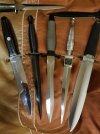This is probably a dumb question, but should the edges of a dagger be extremely sharp? I've looked around a bit and found that some daggers are made and shipped (as the case has been in various wars) with rather blunt edges. The common response to concerns over this is "it's meant to stab, not cut." Of course a sharp dagger seems likely to puncture material much more easily than a blunt one, right? I've also come across this "issue" with things like swords during earlier wars. A cavalry sword would be much more blunt than an infantryman's sword because the riders would generally be galloping at some speed on a horse, and so the less sharpened sword would be adequate. I don't really understand it.
So are daggers and some swords used in the above context issued blunt with the manufacturer assuming they would be sharpened on the other end, or are they actually supposed to be duller for some reason? Seems weird to think soldier's would be expected to sharpen their own daggers and swords.
The only thing I can think is that if the weapon is a sword which is exclusively going to be used while riding at some speed it may be beneficial to the longevity of the weapon to have less than razor sharp edges to preempt damage to the blade. Likewise a dagger made solely to puncture clothing, flesh, and bone may be less prone to chips or damage if it is blunter.
Thanks
So are daggers and some swords used in the above context issued blunt with the manufacturer assuming they would be sharpened on the other end, or are they actually supposed to be duller for some reason? Seems weird to think soldier's would be expected to sharpen their own daggers and swords.
The only thing I can think is that if the weapon is a sword which is exclusively going to be used while riding at some speed it may be beneficial to the longevity of the weapon to have less than razor sharp edges to preempt damage to the blade. Likewise a dagger made solely to puncture clothing, flesh, and bone may be less prone to chips or damage if it is blunter.
Thanks





